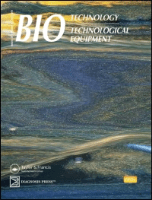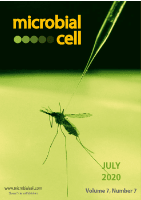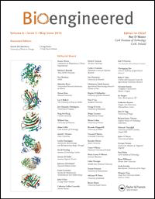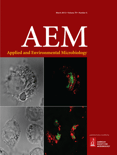
Biotechnology Journal
Scope & Guideline
Fostering a community of innovators in biotechnology.
Introduction
Aims and Scopes
- Molecular Biotechnology:
Research that delves into genetic engineering, including CRISPR/Cas9 applications, gene editing, and the development of novel genetic tools. - Industrial Biotechnology:
Studies focusing on the bioproduction of chemicals, biofuels, and biopharmaceuticals, including the optimization of fermentation processes and bioprocessing techniques. - Cell and Tissue Engineering:
Exploration of methods for developing cell cultures and tissue constructs, including 3D bioprinting and stem cell applications for regenerative medicine. - Bioprocess Optimization:
Research on improving bioprocesses for higher yields and efficiency, including metabolic engineering and the use of bioreactors. - Nanobiotechnology:
Studies on the application of nanotechnology in biomedicine, including drug delivery systems and biosensors. - Environmental Biotechnology:
Research focusing on the use of biotechnological methods for environmental remediation and sustainable practices.
Trending and Emerging
- Synthetic Biology:
An increasing number of studies are focusing on the design and construction of new biological parts, devices, and systems, reflecting the growing importance of synthetic biology in biotechnology. - CRISPR and Genome Editing Technologies:
Research on CRISPR technologies continues to expand, with innovative applications in various organisms and therapeutic approaches being a major focus. - Biomanufacturing and Bioprocessing Innovations:
There is a notable trend towards optimizing production processes using advanced bioreactor designs and continuous manufacturing strategies. - Microbiome Studies:
Research exploring the role of microbiomes in health, disease, and biotechnological applications is gaining traction, indicating a growing interest in microbial diversity and its applications. - Biopharmaceutical Development:
A surge in studies focusing on the production and optimization of biopharmaceuticals, including monoclonal antibodies and viral vectors, highlights the increasing significance of biopharmaceutical research.
Declining or Waning
- Plant Biotechnology:
Research related to genetic modification and biotechnological applications in plants has seen a decline, possibly due to a shift towards more animal and microbial models. - Traditional Bioprocessing Techniques:
Studies focusing on conventional fermentation processes are becoming less prevalent as newer technologies and optimization strategies gain more attention. - Basic Molecular Biology Techniques:
Papers that primarily discuss fundamental molecular biology methods without significant application or innovation are less frequently published.
Similar Journals

CYTOTECHNOLOGY
Cultivating Discovery: Inspiring New Horizons in Bioengineering and Biotechnology.CYTOTECHNOLOGY, an esteemed journal published by Springer, stands as a vital resource in the fields of Bioengineering, Biomedical Engineering, and Biotechnology. With an impact factor reflective of its solid position within academia, this journal encompasses a broad scope dedicated to the advancement of cytotechnological research and applications from its inception in 1987 through to its latest volumes in 2024. Based in the Netherlands, it is committed to providing researchers, professionals, and students with high-quality, peer-reviewed articles that contribute to the understanding and innovations in cytotechnology. Although currently not open access, CYTOTECHNOLOGY has garnered a commendable reputation, holding Q3 rankings in multiple categories, indicating its relevance and influence within the scientific community. Researchers are encouraged to submit their cutting-edge findings to share insights that can spark further advancements in this dynamic field.

BIOTECHNOLOGY & BIOTECHNOLOGICAL EQUIPMENT
Transforming Laboratory Discoveries into Practical SolutionsBIOTECHNOLOGY & BIOTECHNOLOGICAL EQUIPMENT is a leading open access journal published by TAYLOR & FRANCIS LTD from the United Kingdom, dedicated to advancing the field of biotechnology since its inception in 1990. Committed to disseminating high-quality research, the journal has transitioned to open access since 2014, enhancing its accessibility for researchers, professionals, and students alike. With a notable impact in the field, it is categorized in the Q3 quartile for Biotechnology as of 2023 and ranks #193 out of 311 in the Scopus categories for Biochemistry, Genetics, and Molecular Biology. The journal aims to cover a diverse range of topics related to both biotechnological advancements and the equipment that supports them, thus fostering innovative research and practical applications in the biotechnology sector. With an evolving scope that reflects the dynamic nature of biological research, BIOTECHNOLOGY & BIOTECHNOLOGICAL EQUIPMENT plays a crucial role in bridging the gap between laboratory studies and real-world applications, making it an essential resource for anyone involved in biotechnology research.

Microbial Cell
Connecting researchers to cutting-edge microbial insights.Microbial Cell is a distinguished open-access journal published by SHARED SCIENCE PUBLISHERS OG, focusing on the dynamic fields of microbiology, biochemistry, and molecular biology. Since its establishment in 2014, Microbial Cell has been at the forefront of disseminating cutting-edge research essential for advancing our understanding of microbial functions and interactions. With a commendable impact factor and ranking in the top quartiles (Q1 and Q2) across several categories, including Applied Microbiology and Biotechnology and Parasitology, this journal serves as an invaluable resource for researchers, professionals, and students alike. It features a comprehensive scope that encompasses the latest findings in genetics, cell biology, and virology, facilitating the academic community's access to high-quality peer-reviewed work. Microbial Cell not only contributes to advancing microbial sciences but also fosters an inclusive platform for knowledge sharing and collaboration in the scientific community.

Bioengineered
Unlocking the Potential of BiotechnologyBioengineered, published by TAYLOR & FRANCIS INC, is an esteemed Open Access journal that has been at the forefront of research in the fields of bioengineering, biotechnology, and applied microbiology since its inception in 2012. With an impressive impact factor reflecting its high-quality contributions, the journal is categorized in the top quartiles, achieving Q1 rankings in Applied Microbiology and Biotechnology, as well as in Biotechnology and Medicine (Miscellaneous) for 2023. This active engagement in showcasing pioneering research is critical for professionals and students alike, facilitating access to revolutionary studies and methodologies. The journal operates under an Open Access model since 2018, ensuring that groundbreaking findings in bioengineering are readily accessible to a global audience. Situated in the United Kingdom, Bioengineered not only serves as a platform for innovative research but also underscores the importance of interdisciplinary collaborations among scientists, engineers, and biotechnologists.

ELECTRONIC JOURNAL OF BIOTECHNOLOGY
Unlocking Knowledge in Applied Microbiology and BiotechnologyThe Electronic Journal of Biotechnology is a premier Open Access journal published by Pontificia Universidad Catolica de Valparaiso, Chile, dedicated to advancing the fields of applied microbiology and biotechnology. With its inception in 1998 and an unwavering commitment to sharing knowledge, the journal has garnered a respectable ranking within the Q3 quartile for both its biotechnology and applied microbiology categories as of 2023, reflecting its significance in the academic community. Researchers and professionals will find its editorial rigor complemented by a robust platform for disseminating innovative findings, fostering collaboration, and driving forward biotechnology discussions. Given its inclusive approach, having transitioned to Open Access in 2014, the journal ensures that research is accessible to a global audience, making it a valuable resource for students, academics, and industry practitioners alike. Through the publication of original research, reviews, and critical insights, the Electronic Journal of Biotechnology aims to bridge the gap between scientific discovery and practical application, ultimately contributing to advancements in health, agriculture, and environmental sustainability.

APPLIED AND ENVIRONMENTAL MICROBIOLOGY
Connecting Science and Sustainability Through Microbial InsightsApplied and Environmental Microbiology, published by the American Society for Microbiology, stands as a leading journal in the fields of applied microbiology and environmental science since its inception in 1976. With a prestigious Q1 quartile ranking across multiple categories including Applied Microbiology and Biotechnology, Ecology, and Food Science, this journal consistently disseminates high-impact research that drives innovation and advances our understanding of microbial interactions within our ecosystems and industries. As ranked by Scopus, it exhibits prominent rankings in various related fields, underscoring its critical role in shaping contemporary microbiological research. Researchers, professionals, and students alike can stay abreast of groundbreaking studies while contributing to a vast body of knowledge that spans diverse aspects of microbiology, biotechnology, and ecology, ultimately contributing to sustainable practices. Join the community of dedicated scholars and explore vital research findings that impact both environmental health and technological advancement.

Journal of Genetic Engineering and Biotechnology
Pioneering Research for Tomorrow’s Genetic SolutionsJournal of Genetic Engineering and Biotechnology, published by Elsevier Science Inc, is a prestigious open-access journal that stands at the forefront of research in the fields of biotechnology and genetics. Since its inception in 2011, the journal has provided a platform for cutting-edge studies that explore the complexities and innovations within genetic engineering and its applications in biotechnology. With a commendable Impact Factor and recognized as a Q2 journal in both biotechnology and genetics as per 2023 categorization, it ranks well within Scopus, evidencing its influence in the scientific community. Researchers and professionals accessing articles published in this journal benefit from timely contributions that bridge theoretical and practical aspects of genetic technologies. By fostering a collaborative environment, the Journal of Genetic Engineering and Biotechnology aims to promote advancements that drive science forward, making it an essential resource for students, academics, and industry practitioners alike. For those interested in making their mark in these rapidly evolving fields, this journal offers unparalleled access to high-quality, peer-reviewed research.

BIOTECHNOLOGY AND APPLIED BIOCHEMISTRY
Catalyzing Knowledge in Biotechnology and Biochemistry.BIOTECHNOLOGY AND APPLIED BIOCHEMISTRY, published by Wiley, is a renowned journal that bridges the gap between fundamental research and practical applications in the fields of biochemistry and biotechnology. With an ISSN of 0885-4513 and an E-ISSN of 1470-8744, this journal has been instrumental since its inception in 1986, focusing on diverse topics including applied microbiology, drug discovery, and process chemistry. The journal is currently recognized in various categories with impressive quartile rankings, showcasing its influence with placements in Q2 for applied microbiology, biotechnology, and biomedical engineering, among others. Researchers and professionals benefit from its comprehensive scope and critical insights into the latest advancements in these domains. Although not an open-access journal, it provides invaluable access options for academic institutions and professionals seeking to stay at the forefront of biotechnology innovations. Its commitment to presenting quality research facilitates the growth of knowledge and fosters collaborations across disciplines, making it an essential resource for anyone invested in the rapidly evolving landscape of biosciences.

Journal of Biological Engineering
Empowering Research in Biomedical and Environmental EngineeringJournal of Biological Engineering, published by BMC, stands as a prominent Open Access journal since 2007, dedicated to advancing the interdisciplinary field of biological engineering. With an ISSN of 1754-1611, this UK-based journal aims to provide a platform for researchers and professionals to disseminate innovative and impactful research across various domains including Biomedical Engineering, Environmental Engineering, Cell Biology, and Molecular Biology. The journal's notable rankings in the 2023 category quartiles exemplify its position within the scientific community, featuring Q2 status in Biomedical Engineering and Environmental Engineering, along with Q3 in Cell Biology and Q2 in Molecular Biology. By maintaining robust Scopus rankings and ensuring free access to cutting-edge research, the Journal of Biological Engineering plays a crucial role in driving discovery and collaboration among scholars, thereby enriching both the academic landscape and applied sciences.

EuroBiotech Journal
Innovating Solutions for a Healthier TomorrowEuroBiotech Journal, published by SCIENDO, is an essential open-access platform for researchers and professionals in the fields of biomedical engineering, biotechnology, food science, genetics, molecular biology, and molecular medicine. Since its establishment in 2017, the journal has aimed to disseminate high-quality, peer-reviewed research that fosters innovation and collaboration within the European biotechnological landscape and beyond. With its target audience comprising academic scholars, industry practitioners, and students, EuroBiotech Journal has successfully carved a niche, achieving notable Scopus ranks and quartiles, such as Q3 in Biotechnology and Food Science. Based in Warsaw, Poland, the journal welcomes manuscripts that contribute to the vast array of current topics, addressing pressing challenges and discovering solutions pertinent to biotechnology and its applications. As you explore the latest advancements published in this journal, you will find a rich source of knowledge that promotes a deeper understanding of the dynamic and evolving field of biotechnological research.